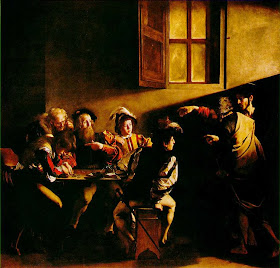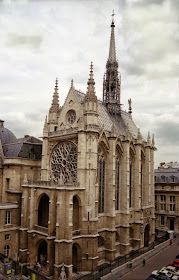The event was not really predictable (nothing Pope Francis does, nor the Holy Spirit for that matter, is predictable), but nor should the responses be surprising.
On the one hand, hypertrad Catholics are claiming that Pope Francis is making up things as he goes along and deviating from "the faith that was handed down, once for all, to the saints" (Jude 1:3). A major Spanish Catholic intellectual, Juan Manuel de Prada, is suggesting that he has essentially capitulated, if not lost his faith, due to what Pope Francis has said. From his first Mass Pope Francis was accused of wanting to dismantle the liturgical reforms of Pope Benedict XVI and cast in suspicion of wanting to suppress the Extraordinary Form; the more vitriolic calling him a heretic and an apostate for washing the feet of a Muslim woman in prison. He stands accused with John Paul II and Benedict XVI for continuing the authentic vision of the Vatican Council which incorporates a broader understanding of the human person in community and how the Church needs to meet the contemporary world with the unchanging Gospel.
One person suggested to me that unless Francis was willing to have homosexual clerics turned over to the secular authorities to be put to death, as his predecessor Pius V did in Horrendum illud scelus, he was deviating from the teachings of his predecessors, if not actually promoting gay clergy and gay marriage. (Parenthetically, consider carefully Fr Zuhlsdorf's explanation of that document: Pius V simply lifted the Church's protection against these secular crimes, much as the Church has done de jure if not always de facto against priests who molest children.) Regardless of their pet grievances, Francis is their poster boy.
On the other hand, the MSM and the other usual Professional Misinterpreters of All Things Catholic are raising the victory banners in triumph as their headlines proclaim that Francis is moving the Church out of the Dark Ages to finally stop her obsessive moralistic posturing against abortion, contraception, and gay marriage. Surely this Pope will finally ordain women priest! The sense of distortion has become cartoonish: some whacked correspondent at Slate has just declared: "Pope Francis is a Flaming Liberal" (and he really seems to mean it).
Even entirely orthodox churchmen are saying things like, "God has given the Church a 21st Century Pastor for a 21st Century Church..."
The last quote reminded me of a similar one by St Augustine, "God has given the Church a 5th Century Pastor for a 5th Century Church." Oops, no I got that one wrong, what he actually said was, "The Church of today, of the present, is the Kingdom of Christ and the Kingdom of Heaven" (City of God, 20.9.1.). What was true in 413 AD is true in 2013 AD.
In short, progressives are clinging on to his every word for signs of change, and distorting his core message to confirm their view of a demotic, nonjudgmental/open/inclusive/welcoming progressive Church that Vatican Two was supposed to usher in, while traditionalists are sifting through his every word for signs of apostasy and confirmation that Modernism has triumphed in the Church against the warnings of Popes Leo XIII, Pius X and Pius XII, again that Vatican Two was supposed to have ushered in.
Pope Francis' pontificacy has so far been a sort of ecclesiastical Rorschach test: folks see in him, in his style, and in his words what they want to see: to the progressive he's a progressive (and that's a Good Thing); to the hypertrad he's a progressive (and that's a Bad Thing). But like a true shibboleth (a Hebrew word that is unpronounceable to the foreigner, and so gives away the fact that the person botching the term is not a member of the tribe), those who have seized upon terms give themselves away as not understanding the Catholic Faith -- whether out of disinterest to give a fair hearing, ignorance, intellectual laziness, malice, ideological blinders, or confusion.
Understanding the right context: relationship
I would suggest that the hermeneutical key to all of Francis' comments about the Church in the modern world, including how she presents herself to an increasingly hostile society, is his understanding of relationship. Both the progressive and the hypertrad miss the whole message of relationship: the progressive, because once the person is reduced to the modern economic unit of utility, and sexuality is removed from its biological and essential role in procreation, there is no necessary relationship; the hypertrad because they seem to substitute a liturgical and doctrinal formalism for the essentially charitable character of what Christian unity means.
The progressive ignores the principles of man as the imago dei and of subsidiarity, the hypertrad ignores the principle of solidarity. Both sides ignore the main point of the Petrine Office that the protections of the Church against error reside in the Keeper of the Keys, and that in the words of Jesus which were recalled by Pius XII in Humani Generis, "He who hears you, hears me" (Luke 10:16). So both the progressive and the hypertrad are now allies in their common attack on the Successor of Peter, a pincer movement from both flanks, each in their own way missing the whole message of relationship that Pope Francis is bring to the world.
For Francis, as for all Catholics, relationship is the heart of the Gospel. God reveals himself in a Trinitarian relationship: relationship is the whole order of the cosmos because it is in the nature of God. Relationship imbues the whole material order: from the way atoms adhere to create molecules to create proteins and amino acids and cells and life, to the way that hydrogen bonding allows ice to float so that life itself can exist as we know it, to the gravitational balance of the entire solar system, with the elliptical orbits and the quirky lunar cycle that was necessary for us to exist.
Throughout salvation history God continues to call humanity into relationship with himself. Emmanuel, "God with us". The Incarnation speaks of the restored relationship between God and man, the spiritual and the material, the body and the soul. The whole Gospel is a call to relationship with us in God, and with each other in Christ and the Church. The very notion of the Church, the Ecclesia, is that we are 'called' (the root of Ekklesia is kaleo, "I call") into relationship with God and one another in Christ. This is the whole mission of Christ: to redeem all of humanity and to give every person throughout time the opportunity to be in relationship with God as his sons and daughters. "For He was made man that we might be made God" (St Athanasius).
 |
| St Athanasius of Alexandria: "For He was made man that we might be made God" |
God made us for relationship: as the Baltimore Catechism simply says:
Q. 150. Why did God make you? A. God made me to know Him, to love Him, and to serve Him in this world, and to be happy with Him forever in the next.In word, relationship.
All of the Church's teachings in theology (matters of faith) are ordered to rightly understanding God and the things of God such that we can have a proper relationship with God as he has revealed himself to us. All of the Church's teachings in matters of morality are ordered toward a right understanding of what it means to love and serve God and each other as fully human beings made in his image and for our happiness. All of the Church's sacraments are ways of participating in the life of Christ and receiving his grace for us to live our lives in healthy relationship with God and with each other. All of the Church's canons and regulations and rubrics and administrative structure find their validity in maintaining and protecting these central teachings that are necessary for the Church to continue throughout history, so that 2000 years after the Passion, Death and Resurrection of Christ we can positively and objectively know the truths of the Gospel and how we ought to live our lives to be holy, healthy, and happy.
I have no doubt that Pope Francis gets this. He is going out to the lost sheep, to the world that is hostile to the Gospel and to Christ and his Church (not always for bad reasons, given the ways that fallen human nature have at times distorted the message of the Gospel from within the Church herself), and he is seeking to establish bridges of communication and common interests to help all men and women of good will find meaning and reconciliation with God through the Gospel. He goes after the lost sheep because he was one of them: self-identifying with St Matthew in the famous Carvaggio painting: Christ personally calls us into relationship.
 |
| “That finger of Jesus, pointing at Matthew. That’s me. I feel like him. Like Matthew.” |
So don't worry that the Holy Father is going to stop teaching the Apostolic faith (for me, an epistemological impossibility), or that he is going to discontinue the Church's vehement opposition to all things that destroy and corrupt human relationship, or that he is itching to suppress the legitimate and salutary liturgical practices of the Benedictine reform, or that he might just go off the reservation and start ordaining women priests or blessing gay unions as sacramental marriages, or anything of the sort.
Pope Francis understands that it is Christ who moves the heart to embrace the virtues that help us to live lives of holiness and order. Our call is to bring others to Christ as that they can be transformed by His love and His sacraments in the Church. Anything artificial or any man made obstacle to the call to relationship with Christ is to be removed. He has been living this all his life as a Catholic, honing it as a Jesuit for some 55 years, and now proclaiming it from the Chair of Peter. This trajectory is the organic continuation of his baptismal vow that made him Catholic, his religious vows that made him Jesuit, the graces of his ordination that made him priest and then bishop, and which must be considered the basis of his pontificacy to bring all people to Christ. He is now doing so on the world stage as the Successor of Peter exactly what he as long done as a simple baptized Catholic and as an archbishop living in poverty among his flock: it is the same thing we are all called to do as baptized Catholics.
Pope Francis is, indeed, more Catholic than the Pope.











